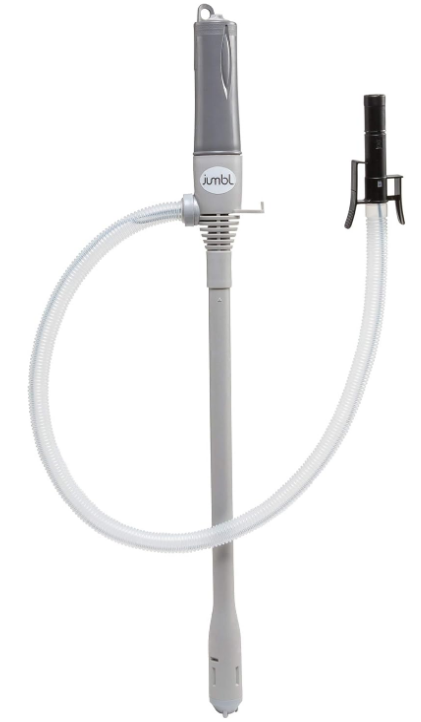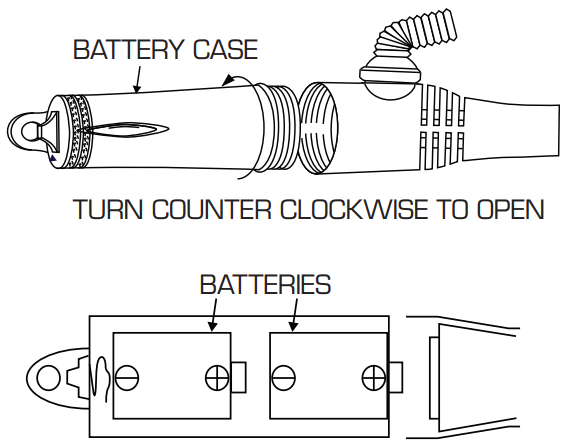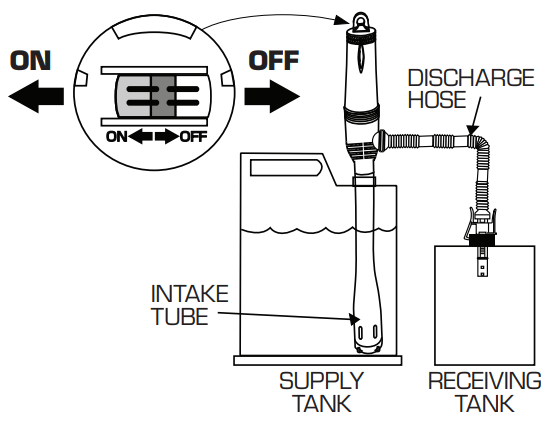Jumbl Fuel Transfer Pump JUBTPASO1 User Guide

Content
Introduction to the Fuel Transfer Pump JUBTPASO1
It is intended to provide you with guidelines to ensure that operation of this product is safe and does not pose risk to the user. Please read all directions before using the product and retain this guide for reference. This product is intended for domestic use only. It is not intended for commercial use.
The Jumbl Fuel Transfer Pump JUBTPASO1 is a powerful, battery-operated device designed for efficient transfer of non-corrosive liquids, including gasoline, diesel, and kerosene. Featuring an automatic shut-off function, it prevents overflow and minimizes spills during operation. The pump boasts a flow rate of 2.3 gallons per minute and comes with an extra-long hose for versatile use. Priced at approximately $30, it is an essential tool for anyone needing quick and safe fuel transfer solutions.
Package Contents
- Transfer pump
- User guide
Features
- Battery operated for portability
- Auto-Stop feature prevents overflow
- Transfers liquids at a rate of 2.3 gallons per minute
- No seal required
- For use with gasoline, kerosene, diesel, light oils, and non-potable water
- Great for emergency generators, yard equipment, and utility machinery
Product Overview

Fuel Transfer Pump JUBTPASO1 Specifications
- Transfer rate: 2.3 gallons/minute
- Power source: 2 D batteries (not included)
- Rated voltage: DC 3V
- Operational voltage: DC 1.7V – 3.3V
- Operating temperature range: 41˚F - 113˚F
- Compatible Liquids: Gasoline, kerosene, diesel, light oils, non-potable water, chemical insecticides, soaps, detergents, deodorants, mild acids, antifreeze
Description
The Jumbl Fuel Transfer Pump JUBTPASO1 is designed to provide efficient and safe fuel transfer operations. The pump's centrifugal design ensures high flow rates while minimizing the risk of clogging. The magnetic drive eliminates the need for seals, reducing maintenance and extending the pump's lifespan. The stainless steel and rubber components ensure durability and resistance to corrosion.
The pump comes with a 10-foot-long suction hose and a 10-foot-long discharge hose, making it easy to maneuver around different fuel containers and vehicles. Additionally, the pump includes a built-in strainer to protect against debris and contaminants.
How to Assemble Your Pump

- Install 2 new D batteries, making sure the polarity on the batteries matches the polarity indicators embossed just above the threaded area of the battery casing. Do not install different types of batteries or partially-charged batteries.
- Screw the sides of the battery casing back together, using a clockwise motion.
- Ensure that the discharge hose is firmly seated before use.
How to Use Your Pump

- Check the unit over before each use to make sure there are no holes in the tubes or hoses.
- Immerse the intake tube into the supply tank from which you wish to transfer fluid.
- Place the nozzle of the discharge hose into the tank to which you wish to transfer fluid, and use the included clip to hold it in place.
- Turn the power switch on to begin transferring liquid.
- The pump will stop automatically when the receiving tank is full. You can also stop the pump manually by turning the power switch of f.
- If you wish to transfer liquid from a new container, you must turn the power switch off, immerse the intake tube into the new container, and then restart the pump.
Setup Guide
To operate the Jumbl Fuel Transfer Pump JUBTPASO1, follow these steps:
- Connect the power source: If using the 12V DC option, connect the positive and negative cables to a suitable battery. For the 120V AC option, plug into a standard wall outlet.
- Attach the suction hose: Insert the suction hose into the fuel source, ensuring it is fully submerged.
- Attach the discharge hose: Place the end of the discharge hose into the fuel tank or container you are filling.
- Turn on the pump: Switch on the power and allow the pump to prime before transferring fuel.
- Monitor and control flow: Use the built-in control valve to regulate the flow rate as needed.
SAFETY PRECAUTIONS
DANGER: FUEL IS EXTREMELY FLAMMABLE. DO NOT SMOKE OR USE AN OPEN FLAME NEAR THE PUMP.
- Don’t use this pump until you thoroughly read and understand all of the operation instructions and warnings. Deviating from these instructions could result in fire, explosions, property damage, and/or operator injury. Don’t try to operate this device without reading the instructions.
- Make sure to familiarize yourself with the appliance itself before using it.
- Before using this appliance, check all the parts to make sure they function properly, and make sure no components have been damaged.
- Keep out of the reach of children.
- Always keep away from heat or flame, and avoid prolonged exposure to sunlight.
- Don’t use a leaking, damaged, or malfunctioning pump. If it’s ever damaged, do not use it, and immediately contact the authorized service center for assistance.
- Pumps that are improperly operated, maintained, or repaired are dangerous! Improper use, service repair, or modification of the pump could result in damage to the product, property damage, or personal injury to the operator.
- Do not inhale gas, fumes, vapor, or spray of fuel, and avoid contact with skin and eyes. If inhaled, immediately move the affected person to fresh air. For skin contact, flush with lots of water. In case of eye contact, rinse immediately with plenty of water and then seek medical advice.
- Storage tanks should be securely anchored to prevent shifting or tipping when full or empty.
- Do not use without liquid. Take care to make sure that liquid does not run out while pump is in operation.
- Do not use with thinner or other solvents.
- Do not use with corrosive liquids.
- Before using pump, make sure that any hot surfaces have cooled down.
- Do not position or store the pump upside-down after use.
- Remove batteries when not in use.
- The pump is not intended for use with drinking water.
Troubleshooting
Common issues and their solutions include:
- No Power: Check the power source connections and ensure they are secure. If using a battery, verify that it is fully charged.
- Low Pressure: Check for blockages in the suction or discharge hoses. Ensure that the pump is properly primed before starting the transfer.
- Leaks: Inspect all connections for signs of leakage. Tighten any loose fittings or replace worn-out parts.
- Warning: Always follow safety guidelines when handling fuel to avoid spills and potential fires.
Pros & Cons
Pros
- High Flow Rate: Efficiently transfers fuel at up to 10 GPM.
- Durable Construction: Built with stainless steel and rubber components for long-lasting performance.
- Easy Setup: Simple to assemble and configure for use.
- Versatile Power Options: Can be powered by either 12V DC or 120V AC.
Cons
- Weight: May be heavier than some other models on the market.
- Noisy Operation: Some users may find the pump noise level to be higher than expected.
- Higher Cost: Pricier compared to basic manual pumps but offers more features and efficiency.
Warranty
This product is covered by a limited one-year warranty. Coverage is subject to limits and exclusions.
WHAT IS THE PERIOD OF COVERAGE?
This limited warranty starts on the date of your purchase and lasts for one year (the “Warranty Period”). The Warranty Period is not extended if we repair or replace the product. We may change the availability of this limited warranty at our discretion, but any changes will not be retroactive.
Customer Reviews
Customers have praised the Jumbl Fuel Transfer Pump JUBTPASO1 for its reliability and ease of use. Common reviews highlight its efficient performance, durable build, and versatility in handling different types of fuels. However, some users have mentioned that it can be quite heavy and noisy during operation.
Common Complaints
- Some users have reported issues with the power cord being too short.
- A few customers have noted that the pump does not come with additional accessories like a carrying case.
Faqs
What is the flow rate of the Jumbl Fuel?
What types of fuels can the Transfer Pump handle?
What are the power options for the Jumbl Fuel?
How do I prime the Jumbl Transfer Pump?
What safety precautions should I take when using the Jumbl Fuel?
Can I use the Jumbl Fuel with my generator?
Is the Transfer Pump easy to assemble?
How often should I maintain the Jumbl Fuel Transfer Pump JUBTPASO1?
What if my Jumbl Fuel Transfer Pump does not turn on?
Can I purchase replacement parts for the Transfer Pump?
Leave a Comment
